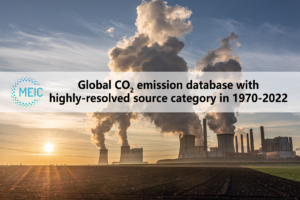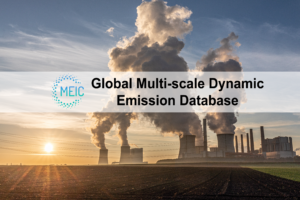2024-12-24
MEIC team published the global high-resolution CO2 emission database
The MEIC team at Tsinghua University cooperated with the team of China Emission Accounts and Datasets (CEADs), Chinese Academy of Environmental Planning of the Ministry of Ecology and Environment, and other research groups, with support from the National Natural Science Foundation of China’s Innovative Research Group Project and the National Key R&D Program, to develop intelligent fusion and modeling techniques for multi-source data and constructed big-data driven methods for high resolution spatiotemporal dynamics characterization and integrated spatiotemporal dynamics scaling. We developed a monthly 0.1° resolution dataset of anthropogenic carbon emissions since 1970.

2023-12-01
MEIC team updated the global CO2 emission database
Tsinghua University cooperated with the team of China Emission Accounts and Datasets (CEADs), Chinese Academy of Environmental Planning of the Ministry of Ecology and Environment, and other research groups, to develop a data-driven approach and construct seamless and highly-resolved energy consumption data cubes for multiple regions, sectors and fuel types. Global CO2 emissions from fossil fuel combustion and cement production in 1970–2021 were then estimated with highly-resolved source category and sub-country information.

2023-05-30
MEIC published the inventory of anthropogenic air pollutants and CO2 emissions in China from 1990 to 2020
MEIC improved the long-term time series of the integrated emission inventory for anthropogenic sources of atmospheric pollutants and CO2 in China from 1990 to 2020, supporting the coordinated control of air pollution and climate change and the synergy of pollution reduction and carbon reduction.
MEIC team

2022-11-15
MEIC published the global multi-scale dynamic CO2 emission database
Tsinghua University cooperates with the team of China Emission Accounts and Datasets (CEADs), Chinese Academy of Environmental Planning of the Ministry of Ecology and Environment, and other research groups, to develop MEIC database to meet the needs of global climate and air pollution research. MEIC builds a global multi-scale atmospheric emission database with long time series, high spatial and temporal resolution, and dynamic updates.
MEIC team

2021-10-14
The Multi-scale Emission Inventory Reanalysis and Data Sharing Platform online!
Recently, a multi-scale emission inventory reanalysis and data sharing platform independently developed by the MEIC team of Tsinghua University was launched on the MEIC website. Emission inventories from multiple research groups are shared on the Data Platform, including Tsinghua University, Peking University, Nanjing University, Jinan University, Beijing University of Technology and Shanghai Academy of Environmental Sciences.
MEIC team

